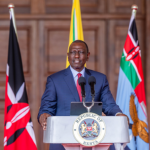The ongoing expansion of Kenya’s road network, coupled with budget challenges and inflationary pressures, has compelled the government to increase the Road Maintenance Levy, according to data from the Ministry of Roads and Transport.
As the value of the country’s road infrastructure reaches approximately Sh4 trillion, marking one of Kenya’s largest public investments, the ministry detailed that inflation and the depreciation of the Kenyan shilling against the dollar have significantly impacted the costs of road construction materials, many of which are imported.
The Road Maintenance Levy (RML) was last adjusted in 2016, increasing from Sh18 to Sh25 per litre of petrol and diesel. This adjustment comes after previous increases over the years, starting from Sh1.5 per litre in 1994 to the current rate. Initially proposed at Sh28 per litre, the new rate aims to generate higher annual revenue for the Road Maintenance Levy Fund (RMLF), though slightly lower than the initial projection of Sh129 billion annually.
The ministry emphasized that the RMLF rate has historically been adjusted upwards to reflect changing economic conditions. Since the last adjustment, the Kenyan shilling has depreciated against major currencies, including the US dollar, pound sterling, euro, and Chinese yuan, increasing the costs of road construction and maintenance due to higher import costs and inflationary pressures.
Despite these adjustments, the annual collections under the RMLF have stagnated at around Sh80 billion since 2016, equivalent to Sh52 billion in 2016 prices, highlighting the ongoing fiscal challenges in maintaining the country’s extensive road infrastructure.
the Road Maintenance Levy Fund (RMLF) needs to collect at least Sh122 billion annually in the Financial Year 2023-24 to maintain its real value at 2016 levels. The report also highlights that the Road Sector Investment Programme (RSIP) for 2018-2022 indicates a growing maintenance backlog due to delayed upkeep, which has escalated from Sh445 billion to Sh727 billion this year.
The annual requirement for road maintenance averages around Sh157 billion, necessitating the recent increase in the levy. During recent public consultations, former Transport CS Kipchumba Murkomen indicated the government’s consideration of alternative revenue sources for road maintenance, particularly as the road network continues to expand.
Given that a significant portion of road construction materials are imported, the depreciation of the Kenyan shilling has further heightened the need for increased funding to procure these materials.
Over the past decade, with support from Development Partners, the government has expanded and rehabilitated the country’s road network, including the establishment of new roads. As of the 2023 Countrywide Road Inventory and Condition Survey, the total road network has expanded to 239,122 kilometers, marking a 48% increase from 2016. The paved network has similarly grown by 47%, totaling 25,410.69 kilometers.
The Ministry emphasizes that maintaining a larger network, especially the paved sections, requires greater financial resources per unit for upkeep. A proposed 48% increase in the RMLF would necessitate adjusting the levy to Sh27 per liter of fuel.
Currently, 69% of the road network is reported to be in good and fair condition, requiring adequate resources to maintain them. Neglecting maintenance could lead to higher long-term costs. Conversely, about 30% of the network remains in poor condition, demanding substantial investment to restore it to a maintainable state.
County roads now span 182,934 kilometers, up from 121,456 kilometers previously, while national trunk roads under agencies like KeNHA, KURA, and KeRRA have expanded from 39,995 kilometers to 56,187 kilometers.
The Kenya Roads Board oversees and coordinates road maintenance, rehabilitation, and development by efficiently utilizing the fund available.
Most of the National Trunk Roads were built more than two decades ago, and as they age, they require rehabilitation and reconstruction for restoration. However, due to declining development budgets and increasing pending bills over the years, there have been fewer funds available for development. This situation has compelled agencies to resort to holding maintenance on these aged roads, resulting in high maintenance costs.
“This exerts more pressure on the available maintenance funds as holding maintenance does not last and requires annual interventions just to keep the roads motorable for a short period of time, hence the need for higher RMLF rates,” stated the ministry in a report.
The fluctuation in government and development partner funds in recent years makes it urgent to maximize the life cycle of newly developed or rehabilitated roads by preserving assets in maintainable condition.
According to official data, the cost of road works has increased significantly: graveling by 51% over six years, resealing by about 20%, overlay by 28%, rehabilitation by 25%, and upgrading to bitumen by 38%.
Due to delayed maintenance on the National Trunk Road network managed by agencies like KeRRA, a substantial number of paved roads have been neglected due to inadequate maintenance resources.
For instance, the 32% RMLF allocation to KeRRA is divided equally among the 290 constituencies (Sh60 million annually), which is insufficient for maintaining the paved road network, including recently completed Low Volume Seal Roads. The Ministry aims to significantly reduce backlog maintenance under RSIP III (2023-27), achievable only with additional RMLF funding.
Despite a reduction in pump prices for the July-August cycle—Sh1 per liter for petrol, Sh1.50 for diesel, and Sh1.30 for kerosene—there has been opposition from some motorists and the public to the increase in the Road Maintenance and Fuel Levy from Sh18 to Sh25 per liter. They urge the government to explore alternative revenue sources instead.
“MAK is opposed to the mid July to August fuel prices where the Road Maintenance and Fuel Levy has been escalated from Sh 18 per litre to Sh 25 per litre, despite submitted objections from the stakeholders and the general public,” the Motorists Association of Kenya said.
Meanwhile, the country’s urbanization growth accompanied with rapid growth in vehicular traffic in many urban areas, is expected to continue exerting pressure on infrastructure, with faster deterioration of the road network translating to higher maintenance requirements.
The transport sector is one of the country’s most vital pillars of economic development, contributing six per cent to the GDP, with roads the most predominant mode of transport in Kenya, accounting for over 90 per cent of all freight and passenger traffic.



